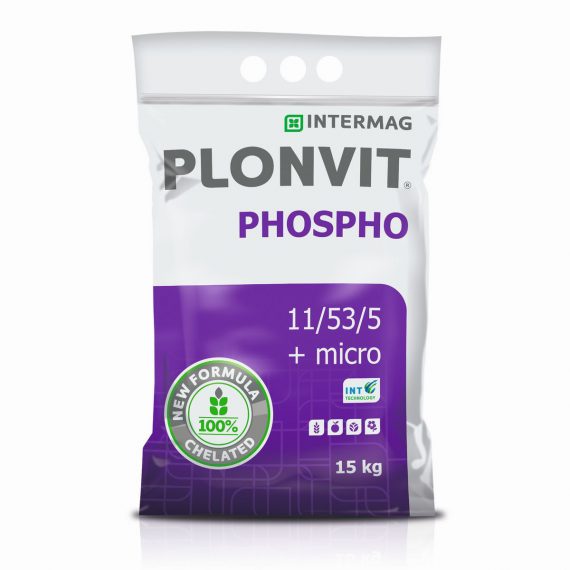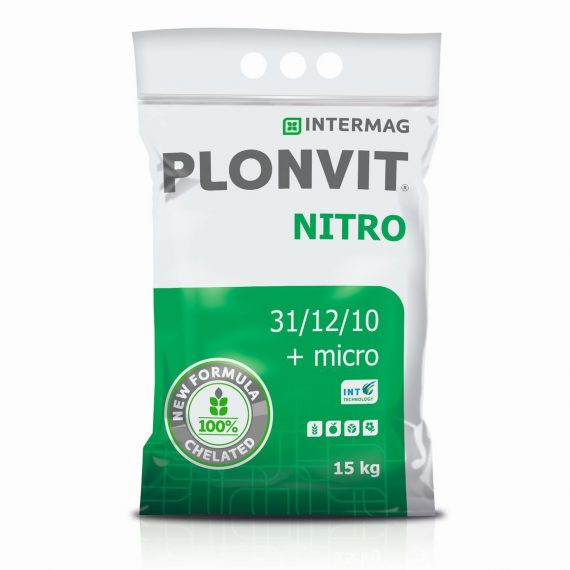Foliar Potassium Phosphorus to enhance the development of the root system, flowering, growth, and fruit ripening.
Plonvit uni pk 10:18
Fast and effective administration of phosphorus and potassium in assimilated forms easily from plants. Enhance the growth of the root system, the flowering and the growth and ripening of the fruits. Increase resistance to adverse growing conditions and improve quality and yield
| Ingredient content | in: | |
| % (w/w) | g/l | |
| Total nitrogen | 2,5 | 35 |
| Uric (N) nitrogen (NH2) | 2,5 | 35 |
| Phosphorus pentoxide (P2O5) | 10,0 | 140 |
| Potassium oxide (K2O) | 18,0 | 245 |
| All ingredients are water soluble | ||
Liquid phosphorus-potassium fertilizer for foliar use or application to the soil with the irrigation system (watering) in the phases of rapid plant growth, in conditions of limited uptake of phosphorus and potassium from the soil and in times of increased need of plants for nutrients. It is especially recommended in periods of drought and low temperatures, as well as during the period of shaping the quality parameters. The use of fertilizer enhances the growth of: the root system, plant and reproductive tissues
| Corp | APPLICATION PERIOD | QUANTITY FOR ONE TIME | |
| PLONVIT UNI PK 10:18[ml/acre] | Spray solution [lit / acre] | ||
| Potato | I: 3–6 leaves have grown on the central shoot (BBCH 13–16); II: from the formation of the main lateral shoots to the complete closure of the rows (BBCH 21–39); III: tuber formation – reaching 20–30% of their final size (BBCH 42–43); IV: tuber formation – reaching 40–50% of their final size (BBCH 44–45); V: tuber formation – reaching 50–60% of their final size (BBCH 45–46); VI: tuber formation – reaching 70–80% of their final size (BBCH 47–48); VII: tuber formation – reaching 80–90% of their final size (BBCH 48–49) |
300-600
|
20–30 lit / acre with fine drops spray or 5–20 lit / acre with small volume sprayers |
| SOY AND OTHER PSYCHIATES | I: beginning of flowering – flowers are still closed (BBCH 51–58); II: end of flowering – pod development (BBCH 69–72); III: 30-50% of pods have reached their standard size (BBCH 73–75) | ||
| APPLES | I: green bud (BBCH 56); II: pink / white bud (BBCH 57-59); III: end of flowering, all petals have fallen (BBCH 69); IV: when the fruits have acquired about 70–80% of the normal size (BBCH 77–78); | 300-600
|
50–100 lit / acre spray with fine drops or 20–50 lit / acre with small volume sprayers |
| CHERRY | I: white bud (BBCH 57–59); II: ovarian development, fruiting (BBCH 71); III: when the fruits have acquired about 50–60% of the normal size (BBCH 75–76); IV: when the fruits have acquired about 70–80% of the normal size (BBCH 77–78); V – VII: after harvest, 2–3 operations every 7–14 days | ||
| PEACHES APRICOTS PLUMS | I: white bud (BBCH 57–59); II: pink bud (BBCH 73–75); III: when the fruits have acquired about 50–60% of the normal size (BBCH 75–76); IV: when the fruits have acquired about 70–80% of the normal size (BBCH 77–78); V: fruit growth (BBCH 81); VI – VIII: after harvest, 2–3 operations every 7–14 days | ||
| Strawberries | I: start of germination – flower growth (BBCH 13–19); II: first flowers at the base of the rosette (BBCH 55); III: white bud (BBCH 58–59); IV: tying of raw fruits – the seeds are clearly visible in the vase (BBCH 73); V: drying of flowers, most of the petals have fallen (BBCH 67); VI: after harvest (BBCH 91–93) | ||
| Pepper | I: 3-5 leaves have developed in the central shoot (BBCH 13–15); II: 1–3 flower buds are visible (BBCH 51–53); III: 9 or more buds are visible – beginning of flowering stage (BBCH 59–61); IV – V: fruit growth 1–6 the pepper has acquired a normal size and shape (BBCH 71–76) | ||
| SOIL TOMATOES | I: 5–7 leaves have grown on the central shoot (BBCH 15–17); II: visible 1–3 flowering (BBCH 51–53); III: the first flower 1–3 open in flowering (BBCH 61–63); IV: did the first tomato grow to normal size at 1–2 cross (BBCH 71–72)? V: did the first tomato grow to normal size at 3–4 cross (BBCH 73–74)? VI: the first tomato acquired a normal size at 5–6 cross (BBCH 75–76) | 300-600
|
40–60 lit / acre spray with fine drops or 20–40 lit / acre with small volume sprayers |
| CUCUMBER ON GROUND | I: 3–5 leaves have grown on the central shoot (BBCH 13–15); II: 6–9 leaves have grown on the central shoot (BBCH 16–19); III: the elongated ovary of 1–2 flowers is visible in the central shoot (BBCH 51–52); IV: the elongated ovary of 6-7 flowers is visible in the central shoot (BBCH 56–57); V: after the first cucumber harvest (BBCH 71) | ||
| CABBAGE White-headed, Chinese-headed red, Italian | I: stage 5–7 leaves (BBCH 15–17); II: stage 2 cards – stage 9 or more cards (BBCH 17–19); III: head development principle (BBCH 41); IV: flower head at 20–30% of normal size (BBCH 42–43); V: flower head at 30–50% of normal size (BBCH 43–45); VI: flower head at 60–80% of normal size (BBCH 46–48) | ||
| ROOT VEGETABLES | I: stage 3–5 real cards (BBCH 13–15); II: principle of development of the parts of the plant collected (BBCH 41); III: the root has acquired 20-40% of the final size (BBCH 42–44); IV: the root has acquired 50-70% of the final size (BBCH 45–47) | ||
| Bulbous Vegetables | I: visible 3–5 true leaves (BBCH 13–15); II: principle of development of the parts of the plant collected (BBCH 41); III: 30% of the final bulb diameter has been reached (BBCH 43); IV: 50% of the final bulb diameter has been reached (BBCH 45); V: in 10% of plants the leaves are twisted (BBCH 47) | ||
| PSYCHANTHI | I: stage 3–5 real cards (BBCH 13–15); II: growth of stems: (pea BBCH 31–39), (beans BBCH 21–29); III: flower head development (BBCH 51–55) | ||




